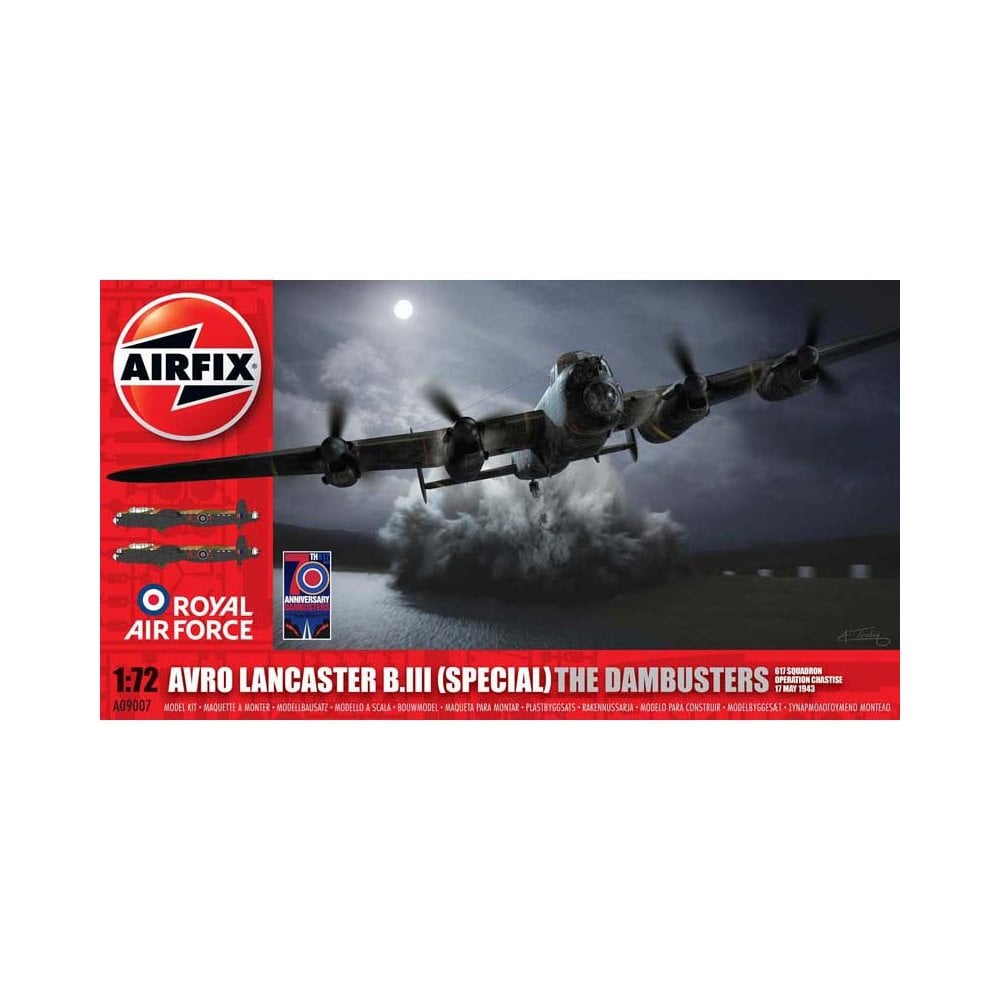1/72 Avro Lancaster Dambusters Airfix A09007Number of Parts: 239Dimensions (mm): L294 x W432Airfix Avrlo Lancaster Bomber. While the Lancaster saw the vast majority of its service as a high altitude night bomber attacking strategic targets deep within Germany, notably its involvement in the battles of the Ruhr, Hamburg and Berlin, it was a daring low-level raid that gave the Lancaster arguably its finest hour.1/72 Avro Lancaster Dambusters Airfix: The Dambusters raid, as it has since become known, was one the most famous operations of the war. Led by Wing Commander Guy Gibson, the 19 specially modified Lancaster bombers attacked the Mohne, Eder, Sorpe and Ennepe dams, with the Mohne and Eder dams being breached. This caused widespread destruction to both the German war effort and to food production.The dams were breached using a special type of bomb, the Upkeep mine, or ‘bouncing bomb’. This was rotated before being dropped so that it skipped along the surface before impacting against the dam, sinking and exploding, thus rupturing the dam. This avoided the need for a high altitude raid and avoided the torpedo nets. The attack was a partial success but greatly improved the morale of the Allies and the British public.The Avro Lancaster Bomber had its origins in an aircraft designed to specification E.13/36 of 1936 which was for a new generation of heavy twin engine medium bombers. This specification resulted in the Handley Page Halifax and the Avro Manchester. The Manchester was designed by Avro’s chief designer Roy Chadwick and was a relatively conventional, but large for its day, mid wing monoplane with low set tail plane and twin fins powered by a pair of Rolls Royce Vulture “X” configuration 24 cylinder engine. The aircraft was protected by a power operated Frazer Nash nose turret armed with a pair of .303 browning machine guns, a similar turret in the tail with four machine guns. Possibly the most unusual feature of the aircraft was its extremely large bomb bay extending along almost half of its underside. The Manchester first flew at Ringway on July 24th 1939 but despite substantial efforts which were put into the development of the design it was consistently let down by the underdeveloped Rolls Royce Vulture engines which had a habit of either breaking con rods, bursting into flames, or both.The aircraft was placed in production regardless as the RAF was in no position to turn down any aircraft by this time due to the start of the war. Despite this Roy Chadwick remembered conversations he had with Rolls Royce engineers about a new mark of Rolls Royce Merlin engine of the type that was fitted to Spitfire fighters. The power output of this remarkable engine had just been increased dramatically by fitting two stage, two speed supercharges and the comment was made that it would improve the performance of the Manchester dramatically. Chadwick decided there was little point in half measures and decided that the solution was to take off the Manchester’s wings, replace the engines with Merlin’s and so he designed a new centre section wing which mounted a further two Merlin engines before re attaching the original outer wings to the larger centre section. This centre section was really the secret of the Lancaster’s success in that it was built extremely strongly, but remained light. When coupled to the very strong bomb bay structure it made for a very strong aircraft. The Merlin engines were proven and reliable and the addition of two extra engines gave the new aircraft remarkable lifting power.On the 31st January 1941 the prototype Lancaster BT308 made her maiden flight. Other fairly major changes had been from the Manchester design, notably the installation of a dorsal turret armed with two .303 machine guns and a ventral turret with the same armament. The tail plane configuration was experimented with, the aircraft at one stage having triple tail fins, but this was finally settled with the same configuration as the production Manchester but with much enlarged twin fins. This gave the mid upper gunner a much better field of fire. The initially production model of Lancaster was the B1.
£46.99 Original price was: £46.99.£42.29Current price is: £42.29.
1/72 Avro Lancaster Dambusters Airfix A09007
Out of stock
This product is currently sold out.
Don't worry! Enter your email and we'll notify you when it's available again.
| Weight | 0.71 kg |
|---|
Brand
Airfix
Browse our Airfix Model Kits & Accessories
Explore our range of Airfix model kits and accessories today. Our Airfix collection includes various scales, including 1/72, 1/48 and 1/43. We also have an excellent selection of vehicles, such as aeroplanes, classic cars and ships. Making your models look even more realistic has never been so easy with our paints and weathering products. If you're struggling to find what you're looking for, get in touch, and one of our experienced staff members will be in touch with you.
- Royal Mail Tracked (Standard)** (£3.89) 2-3 Working Days***
- Royal Mail Tracked (Express)** (£5.99) 1-2 Working Days***
- FedEx (£8.99) Next Working Day***
- Free – 2-6 Working Days*
** Limited to maximum weight of 2kg
*** These are not guaranteed delivery times and delays are possible
*Free delivery is subject to restrictions, orders between £60-£99.99 containing products that can only shipped with Royal Mail. Orders that include products like aerosols, large quantity of flammable products or over maximum size and weight allowed by Royal Mail will not be sent free and are subject to a carriage charge, Orders over £100 are not subject to restrictions and apply to UK Mainland only. Orders containing hazardous or oversized goods cannot be shipped to NI, IOM, IOW, Highlands, these are excluded from our free shipping.
Order cutoff times - Monday 11am, Tuesday to Friday 12pm.
Order processing days Monday-Friday
Working days are Monday to Friday and do not include weekends

